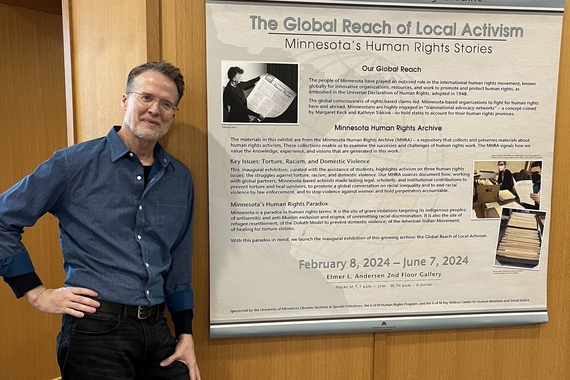The Fragile State: Professor McNamara's Research on IDPs in El Salvador
El Salvador is in a precarious position, both socio-politically and geographically.
From 1980 to 1992, the country was embroiled in a deadly civil war between the military government and the Farabundo Martí National Liberation Front (FMLN). About 80,000 people were killed and approximately one million were forcibly displaced. Although over twenty-five years have passed since the conclusion of the war, this massive displacement laid the foundation for the current plague of ongoing violence at the hands of criminal organizations.
The following excerpt written by Professor McNamara explains the phenomenon further:
The gangs of El Salvador today are following a well-known and successful trajectory towards political legitimacy, despite their history of brutal violence that make this goal appear na ̈ıve and misguided. In fact, the decades-long rivalry and hostility between the ARENA and FMLN parties has created a space for the gangs to more effectively enter the political system. Officials estimate that as many as 600,000 family members and allies support the general tactics and political objectives of the gangs. These supporters are people who have not benefited from the political order established after the civil war, or from the new economic programme initiated by the Central American Free Trade Agreement with the US in 2006. Gang leaders argue that they are protecting the most vulnerable people of society from arbitrary abuse of public security forces, that politicians commit open corruption by stealing government funds, and that the economy benefits only a small elite. The gangs or maras, along with their civilian constituency, are tired of being ignored, and frustrated by the lack of assistance to relieve extreme poverty. Source: Patrick J McNamara, "Political Refugees from El Salvador: Gang Politics, the State, and Asylum Claims," Refugee Survey Quarterly, Volume 36, Issue 4, 1 December 2017, Pages 1–24.
Then there is the issue of geography; El Salvador sits atop an unstable fault line which has led to twenty-seven earthquakes of magnitude 6.0 or higher since 1992.

Rampant gang violence, endemic poverty, lack of a proper social safety net, and the constant risk of natural disaster threatens to raise the number of internally displaced persons, which already sits in the tens of thousands, with many more people who would leave their homes if they could find safety somewhere else in the country. This prompted Professor Patrick McNamara to formulate his Human Rights Initiative Grant-funded project, “From IDPs to Refugees: Forced Migration in El Salvador.”
Due to significant changes in the phenomenon of displaced populations since the 1951 Refugee Convention and its 1967 Protocol, the small size of the El Salvador, and the evolving relationship between Salvadorian IDPs and the United States, knowledge of the situation is limited. McNamara’s project seeks answers in a place that is riddled with questions and uncertainties in order to aid organizations and policymakers in El Salvador and the United States. As McNamara puts it, “The policy challenges to adequately protect the personal security and humanitarian needs of IDPs in El Salvador is directly related to the legal and humanitarian struggle of thousands of refugees seeking asylum in the United States.”
McNamara’s specific motivations are:
- The urgent need for more information about people displaced by gang-related violence in El Salvador
- The sincere expectation that the government of El Salvador acknowledge the humanitarian needs of the estimated 328,000 people displaced by this violence
- The critical assistance the government of El Salvador requires from NGOs, other governments, and United Nations agencies to meet the needs of IDPs
- The pressing demand that the government of the United States fully consider how its deportation approach to asylum applicants exacerbates the humanitarian crisis in El Salvador.
But just how bad is the situation in El Salvador? The Salvadoran government’s reluctance to acknowledge the IDP situation and failure to protect its IDPs according to international humanitarian agreements led McNamara to conclude that “that unless the Salvadoran state adequately responds to the UN expectation of its ‘responsibility to protect’ civilians, it will likely be considered an increasingly ‘fragile state’ by the international community.”
It is easy to lose sight of an individual’s plight when dealing with forces so great in scale; such as economics, mass migration, natural disasters, and wide-reaching criminal organizations. McNamara believes it is critical that the individual experiences of refugees receive attention and research as well. “The danger and trauma of the migration journey from El Salvador to the United States cannot be ignored.” From the dangers of the journey itself (Some 80% of women and girls reported being raped at some point along their migration north) to the psychological impacts of the long, complex immigration process that often proves unsuccessful, the human experience is important piece of the project.
With help and support from his Graduate Research Assistants, Paula Cuellar Cuellar and Heider Tun Tun, McNamara has visited with IDPs, government ministries, and NGOs in El Salvador and with refugees at detention centers in Texas. The team hopes to distribute their article in both English and Spanish to NGOs, scholarly publications, U.S. lawmakers, and to international refugee and human rights organizations in order to improve the lives of Salvadoran IDPs and refugees the world over.



